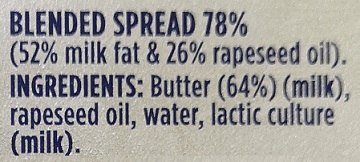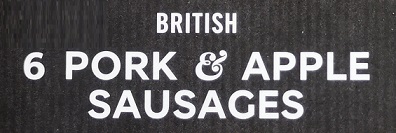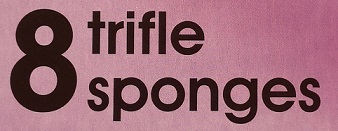
| Department of Food and Nutritional Sciences, The University of Reading
Food Labelling in the UK - A supporting material page |
Legal names
The first option to consider is whether there is a required legal name for a product. There are a limited number of these but, if a legal name is specified in legislation, then it must be used.
An example of a sector where these exist is for spreadable fats (including butter). Regulation (EU) No 1308/2013, establishing a common organisation of the markets in agricultural products, provides the rules. Relating to 'spreadable fats for human consumption', this states: 'The sales descriptions of these products shall be those specified .... The sales descriptions in Appendix II shall be reserved to the products defined therein with the following CN codes and having a fat content of at least 10 % but less than 90 % by weight.'
The figure below is part of the back panel for a Spreadable fat product showing both the product name and the ingredients. The legal name is 'Blended Spread 78%' which meets the 'sales description' specified in Appendix II in Annex VII of Regulation 1308/2013:

Customary names
Customary names are those which are 'accepted as the name of the food by consumers in the United Kingdom in which that food is sold, without that name needing further explanation.' It is not always easy to determine what might be considered as a customary name but the following are examples of names used on a few products. Without some knowledge of what the name means, it would be difficult to know what the product consists is in these cases. These can be considered as 'customary names'. In some cases, producers may choose to add a more detailed description but, in these cases, there was no additional explanation:
![]()



Descriptive names
Many products will have a descriptive name which is designed to provide the purchaser with more information - or, to use the legal words: 'sufficiently clear to enable consumers to know its true nature and distinguish it from other products with which it might be confused'. The images below are taken from a pack of Speciality sausages. The first image shows the main text from the front of the pack - this gives the purchaser an indication of the type of sausage but is insufficient for a descriptive name. The second image is taken from the back panel of the product where there is a separate statement which provides the full descriptive name required by the legislation.


A second examples is provided by text from a packet of Trifle sponges. The first image below shows the main name from the front of the pack. The second image shows the more detailed descriptive name taken from the back of the pack (where additional mandatory information is also given):


For the main index page for this site, go to Food Labelling in the UK: A Guide to the Legal Requirements